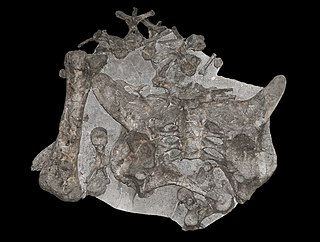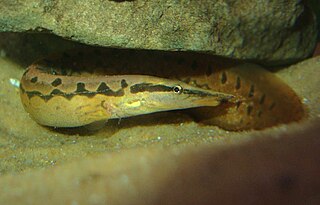
Dacentrurus, originally known as Omosaurus, is a genus stegosaurian dinosaur from the Late Jurassic to Early Cretaceous of Europe. Its type species, Omosaurus armatus, was named in 1875, based on a skeleton found in a clay pit in the Kimmeridge Clay in Swindon, England. In 1902 the genus was renamed Dacentrurus because the name Omosaurus had already been used for a crocodylian. After 1875, half a dozen other species would be named but perhaps only Dacentrurus armatus is valid.

Portunus trituberculatus, the gazami crab, South Korea's blue crab or horse crab, is the most widely fished species of crab in the world. It is found off the coasts of East Asia and is closely related to Portunus armatus.

The zig-zag eel, also known as the tire-track eel, tire-track spiny eel or marbled spiny eel, is a species of ray-finned, spiny eels belonging to the genus Mastacembelus of the family Mastacembelidae, and is native to the riverine fauna of India, Bangladesh, Pakistan, Sri Lanka, Thailand, Vietnam, Indonesia and other parts of South East Asia. The species was described as Macrognathus armatus by Lacepède in 1800. Other common names for this popular aquarium species are leopard spiny eel and white-spotted spiny eel. This species is not only a popular aquarium fish but also as a food fish in its country of origin.
Hisonotus is a genus of armored catfishes native to South America. Species of Hisonotus and Curculionichthys are the only representatives of the subfamily Otothyrinae having serrae on the posterior edge of the pectoral fin spine. These species are small fishes, generally found in small fast flowing streams, where they grasp to the branches and leaves of aquatic or subaquatic plants. The species of this genus mostly occur in Atlantic coastal streams of southern Brazil and the Paraguay-Paraná system of southern South America. They are also distributed in the Río de La Plata basin and coastal rivers of southeastern Brazil.

Pagurus armatus, the armed hermit crab or black-eyed hermit crab, is a species of hermit crab found in the eastern Pacific Ocean of the United States and British Columbia, Canada.
The bony-eared assfish is a bathypelagic species of cusk-eel found in tropical and sub-tropical oceans at depths of from 1,171 to 4,415 metres. It has been found as far north as Queen Charlotte Sound off British Columbia's coast. This species grows to a length of 37.5 centimetres (14.8 in) SL. It is the only known member of its genus Acanthonus.
Petrolisthes armatus, the green porcelain crab, is a species of small porcelain crab in the family Porcellanidae. It is believed to be native to Brazil but has spread to other parts of the world. Populations in the south eastern part of the United States have increased dramatically and the species is considered to be an invasive species.
Hisonotus aky, sometimes known as the green hisonotus, is a species of catfish in the family Loricariidae. It is native to South America, where it occurs in Argentina's Uruguay River basin. It reaches 4 cm SL. It was formerly considered a member of the genus Epactionotus, although it was transferred to Hisonotus in 2009.
Hisonotus chromodontus is a species of catfish in the family Loricariidae. It is native to Brazil, where it occurs in the Tapajós basin. The species is usually found in shallow flat parts of creeks with clear water, low current, and sandy substrate. It reaches 3.3 cm SL.
Hisonotus depressinotus is a species of catfish in the family Loricariidae. It is native to South America, where it occurs in the Tietê River basin. The species reaches 3 cm SL. It is not to be confused with the related species Hisonotus depressicauda, which has a similar name and is found in the same river basin.
Hisonotus iota is a species of catfish in the family Loricariidae. It is native to South America, where it occurs in the Chapecó River, which is a tributary of the Uruguay River. The species reaches 3.3 cm SL.
Hisonotus montanus is a species of catfish in the family Loricariidae. It is known only from the Canoas River drainage in Brazil and reaches 4.5 cm SL. The specific epithet of this fish, montanus, derives from its tendency to be found at altitudes of roughly 850 m or 2789 ft above sea level, marking it as the species of Hisonotus that occurs at the highest elevation of those native to the Uruguay River basin.
Hisonotus notatus is a species of catfish in the family Loricariidae. It is a freshwater species native to Brazil, where it occurs in the São João River and other coastal drainages of the stae of Rio de Janeiro. It reaches 4.3 cm SL and is the type species of the genus Hisonotus. It was formerly considered conspecific with Hisonotus thayeri, but a 2016 revision by Fernanda Martins and Francisco Langeani redescribed H. notatus and adopted the new name H. thayeri to some populations formerly classified as H. notatus.

Hisonotus paulinus is a species of catfish in the family Loricariidae. It is native to South America, where it occurs in the Tietê River basin. The species reaches 4 cm SL.
Hisonotus prata is a species of catfish in the family Loricariidae. It is a freshwater species native to South America, where it occurs in the Taquari River drainage and the Lagoa dos Patos system. It reaches 3.3 cm SL.
Hisonotus ringueleti is a species of catfish in the family Loricariidae. It is native to South America, where it occurs in the Uruguay River basin. It is found mainly in vegetated areas inhabited by species belonging to the plant genera Ludwigia and Potamogeton, among others. It occurs in both slow and fast-flowing clear creek environments with a substrate of stones, mud, or gravel. The species reaches 4.3 cm SL.
Hisonotus taimensis is a species of catfish in the family Loricariidae. It is native to South America, where it occurs in the Lagoon Mirim drainage. The species reaches 6.6 cm SL.
Hisonotus vespuccii is a species of catfish in the family Loricariidae. It is a freshwater species native to South America where it occurs in the São Francisco River and three of its tributaries: the Das Velhas River, the Paraopeba River, and the Formoso River. It is found in areas with marginal vegetation and reaches 3.6 cm (1.4 in) SL. The species was named after the Italian explorer Amerigo Vespucci.
Hisonotus vireo is a species of catfish in the family Loricariidae. It is native to South America, where it occurs in the Jacuí River basin and the Lagoa dos Patos system in Brazil. The species reaches 4 cm SL.
Hisonotus devidei is a species of catfish in the family Loricariidae. It is a freshwater species native to South America, where it occurs in the Pandeiros River, a tributary of the São Francisco River. The species was described in 2018 by F. F. Roxo, G. S. C. Silva, and B. F. Melo on the basis of morphology and patterning, as it differs from other members of the genus Hisonotus by the presence of distinctive dark blotches. FishBase does not list this species.




